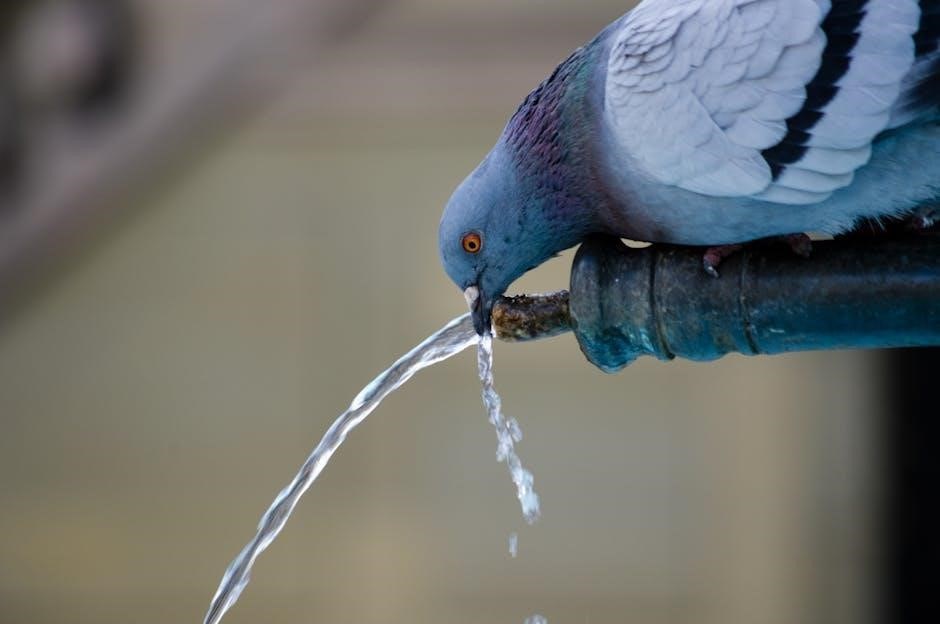Pipe cutting is a fundamental process in various industries, requiring precision and safety․ It involves cutting pipes to specific lengths using specialized tools and techniques․ This guide provides a detailed overview of the process, tools, and best practices to ensure accurate and safe pipe cutting operations․
Overview of Pipe Cutting
Pipe cutting is a critical process in plumbing, construction, and manufacturing, involving the precise severing of pipes to meet specific project requirements․ It ensures proper fitment, alignment, and functionality in systems like water supply, gas lines, and HVAC․ Various materials, such as steel, PVC, copper, and PEX, require different techniques and tools․ Common methods include using pipe cutters, saws, or torches, each suited for specific pipe types and diameters․ Accurate measurement and marking are essential to achieve clean, professional cuts․ Safety is paramount, as improper cutting can lead to leaks, structural weakness, or hazards․ This guide covers tools, techniques, and best practices for efficient and safe pipe cutting across industries․
Importance of Pipe Cutting in Various Industries
Pipe cutting is indispensable in numerous industries, including construction, plumbing, oil and gas, and manufacturing․ In construction, precise pipe cutting ensures proper fitting of water and gas lines, while in plumbing, it allows for efficient system installation and repair․ The oil and gas industry relies on accurate pipe cutting for safe and leak-free connections․ Manufacturing industries use pipe cutting to create components for machinery and equipment․ Each industry demands high precision to maintain safety, functionality, and structural integrity, making pipe cutting a vital skill with wide-ranging applications․ Proper techniques and tools are essential to meet these demands effectively․

Types of Pipes Commonly Cut
Steel, PVC, copper, and PEX pipes are frequently cut due to their versatility in plumbing and industrial applications, each requiring specific techniques for precise results․
Steel Pipes
Steel pipes are widely used in construction and industrial settings due to their durability and strength․ They are available in various types, such as carbon steel, stainless steel, and galvanized steel, each offering different properties suited for specific applications․ Cutting steel pipes often requires powerful tools like reciprocating saws, angle grinders, or torch cutters․ Proper techniques are essential to avoid warping or creating uneven edges․ Safety measures, including wearing protective gear and ensuring good ventilation, are crucial when cutting steel pipes․ Regular maintenance of cutting tools ensures optimal performance and longevity, making steel pipe cutting efficient and reliable in demanding environments․
PVC Pipes
PVC pipes are widely used in plumbing and drainage systems due to their lightweight, corrosion-resistant, and cost-effective properties․ They are easier to cut compared to metal pipes, often requiring only a pipe cutter or a saw․ For precise cuts, marking the pipe with a measuring tape and ensuring it is firmly held in place is essential․ After cutting, smoothing the edges with a file or sandpaper prevents sharp burrs․ PVC pipes are ideal for DIY projects and professional installations alike, offering versatility and durability for various applications․ Proper cutting techniques ensure leak-free connections and long-lasting performance in water supply and drainage systems․
Copper Pipes
Copper pipes are commonly used in plumbing and heating systems due to their durability and resistance to corrosion․ Cutting copper pipes requires careful precision to ensure clean, professional results․ Tools like pipe cutters or reciprocating saws are typically used for this purpose․ After cutting, it’s essential to clean the edge with a file or sandpaper to remove any sharp burrs․ Properly cut copper pipes ensure leak-free connections and optimal performance in water supply and heating systems․ While copper pipes are more durable than PVC, they are heavier and more expensive, making them a preferred choice for high-quality installations where longevity is a priority․
PEX Pipes
PEX pipes, or cross-linked polyethylene pipes, are flexible and widely used in plumbing systems due to their ease of installation and resistance to freezing․ Cutting PEX pipes requires specialized tools like a PEX tubing cutter to ensure clean, precise cuts without damaging the material․ Unlike rigid pipes, PEX pipes can be bent around corners, making them ideal for complex layouts․ After cutting, it’s essential to deburr the edges to prevent debris from causing issues in the system․ Proper cutting techniques ensure leak-free connections, making PEX pipes a popular choice for modern plumbing installations․

Tools and Equipment for Pipe Cutting
Pipe cutting requires specialized tools like pipe cutters, reciprocating saws, and angle grinders․ These tools vary in design and functionality, catering to different pipe materials and sizes․
Pipe Cutters
Pipe cutters are essential tools designed specifically for cutting various types of pipes․ They are available in manual and automatic versions, offering precision and ease of use․
Reciprocating Saws
Reciprocating saws are versatile tools commonly used for cutting pipes in various materials, including metal and plastic․ They are ideal for tight spaces and offer portability․ Blades are interchangeable, with options like carbide-tipped for tough materials․ When cutting pipes, secure the pipe in a vise for stability․ Apply steady pressure and maintain a consistent cutting motion․ For thicker pipes, use a slower speed setting to prevent blade wear․ Regular blade replacement ensures optimal performance․ Always wear safety goggles and gloves when operating a reciprocating saw to protect against debris and sparks․
Angle Grinders
Angle grinders are powerful tools commonly used for cutting pipes, especially thick metal pipes․ They are versatile and can be equipped with different cutting wheels for various materials․ For pipe cutting, an abrasive wheel is typically used, while diamond blades are preferred for tougher materials․ To ensure a clean cut, secure the pipe in a vise and guide the grinder steadily along the marked line․ Apply consistent pressure but avoid applying too much, which can cause the blade to bind․ Safety is crucial; always wear goggles and gloves to protect against sparks and debris․ Regularly maintain the grinder to ensure optimal performance and longevity․
Torch Cutting
Torch cutting is a widely used method for cutting thick metal pipes, particularly steel․ It involves using an oxy-acetylene or plasma torch to heat and melt the metal․ This technique is ideal for cutting heavy-duty pipes in industrial settings․ Proper preheating is essential to achieve a clean cut․ The torch is guided along the marked line, maintaining consistent pressure to ensure accuracy․ Safety precautions are critical, as the process generates intense heat and sparks․ Always use protective gear, ensure good ventilation, and keep flammable materials away․ Torch cutting offers precision for complex cuts but requires skill and experience to avoid warping or damaging the pipe․ Regular maintenance of the torch ensures optimal performance and safety․

Safety Precautions in Pipe Cutting
Safety is paramount in pipe cutting to prevent accidents․ Always wear protective gear, including gloves, safety glasses, and a face mask․ Ensure proper ventilation to avoid inhaling fumes․ Keep flammable materials away and have a fire extinguisher nearby․ Regularly inspect tools for damage and follow manufacturer guidelines․ Never cut near open flames or sparks, and ensure the work area is well-lit․ Proper training and adherence to safety protocols minimize risks, ensuring a safe working environment for all involved in the process․
Personal Protective Equipment
Personal protective equipment (PPE) is essential for ensuring safety during pipe-cutting operations․ Safety glasses or goggles protect eyes from debris, while a face mask prevents inhalation of dust and fumes․ Gloves provide grip, preventing tools from slipping and protecting hands from cuts and abrasions․ Steel-toe boots safeguard feet from heavy tools or falling objects․ Hearing protection, such as earplugs, is necessary when using loud power tools like reciprocating saws or grinders․ A welding helmet with a shaded lens is required for torch cutting to protect against intense UV/IR radiation․ Proper PPE ensures a safer working environment and minimizes risks of injury or long-term health issues․ Always inspect PPE before use and replace worn or damaged items immediately․
Proper Ventilation
Proper ventilation is crucial when cutting pipes to prevent the inhalation of harmful fumes and particles․ When cutting metal or PVC pipes, processes like grinding or torch cutting release dust, sparks, and toxic gases․ Adequate airflow helps dissipate these hazards, reducing health risks․ Work in well-ventilated areas, such as outdoors or in workshops with open windows․ Use fans or exhaust systems to direct fumes away from the workspace․ For indoor tasks, consider using fume extractors or respirators with filters designed for the specific materials being cut․ Poor ventilation can lead to respiratory issues or explosions from flammable vapors, making it a critical safety measure in all pipe-cutting scenarios․
Fire Safety Measures
Fire safety is paramount during pipe cutting, especially when using torches or high-temperature tools․ Sparks and heat can ignite flammable materials nearby․ Keep a fire extinguisher rated for metal and chemical fires within easy reach․ Ensure the workspace is clear of combustible materials like wood, fabric, or grease․ When cutting near flammable liquids or gases, use explosion-proof equipment․ Never leave hot tools unattended, and avoid cutting near open flames or sparks․ Properly store fuel and oxygen tanks away from heat sources․ Post emergency contact information and train personnel in fire response․ Regularly inspect equipment for leaks or damage to prevent accidental ignition․ These measures ensure a safer environment for everyone involved in the cutting process․

Step-by-Step Pipe Cutting Process
Measure and mark the pipe accurately, choose the right tool, perform the cut carefully, and smooth the edges for a clean, professional finish․
Measuring and Marking the Pipe
Accurate measurement is crucial for successful pipe cutting․ Use a high-quality tape measure to determine the required length․ Mark the pipe clearly with a pencil or marker, ensuring visibility․ For precise alignment, consider using a pipe marker or clamp to hold the pipe steady․ Double-check measurements to avoid errors․ Proper marking ensures clean cuts and minimizes waste․ Always account for any pipe fittings or connectors when measuring․ This step sets the foundation for an accurate and efficient cutting process, reducing the risk of uneven cuts and ensuring professional results․ Attention to detail here guarantees better outcomes in subsequent steps․
Choosing the Right Tool for the Job
Selecting the appropriate tool for pipe cutting is essential for achieving precise and efficient results․ Different pipe materials, such as steel, PVC, or PEX, require specific tools to ensure clean cuts․ Pipe cutters are ideal for smaller diameters and provide quick, clean results․ Reciprocating saws, equipped with the right blade, are versatile and suitable for larger pipes․ Angle grinders offer precision and are often used for thick-walled pipes, while torch cutting is best for heavy-duty applications․ Consider the pipe material, thickness, and desired finish when selecting a tool․ Using the right equipment ensures safety, accuracy, and professional-quality outcomes․ Proper tool selection is a critical step in achieving successful pipe cutting results․
Performing the Cut
Performing the cut requires careful attention to technique and safety․ Start by ensuring the pipe is securely held in place to prevent movement․ Use steady, consistent pressure with the chosen tool, maintaining proper alignment․ For manual tools like pipe cutters, rotate the cutter around the pipe while tightening gradually․ Power tools, such as reciprocating saws or grinders, should be operated at recommended speeds to avoid overheating․ When using a torch, maintain a steady flame and follow the manufacturer’s guidelines for temperature and technique․ Always wear personal protective equipment, including gloves and safety glasses, to protect against sparks and debris․ Proper technique ensures clean, precise cuts and minimizes material waste․ Safety and precision are key to successful pipe cutting operations․
Smoothing the Edges
Smoothing the edges of a freshly cut pipe is essential for safety and proper fitment․ Use a file, emery cloth, or grinder to remove sharp burrs and rough surfaces; For metal pipes, a deburring tool or sandpaper can create a smooth finish․ Apply gentle, even pressure to avoid damaging the pipe material․ PVC and PEX pipes can be smoothed with a utility knife or a dedicated deburring tool to prevent cracks․ Properly smoothed edges ensure leak-free connections and prevent damage to fittings or seals․ Regularly inspect and maintain tools to achieve consistent results․ Smooth edges are critical for both functionality and safety in piping systems․

Troubleshooting Common Issues
Identify and address common pipe cutting issues like uneven cuts, damaged ends, or tool malfunctions․ Check tool sharpness, alignment, and technique․ Adjust as needed for precise results․
Dealing with Uneven Cuts
Uneven cuts can occur due to dull blades, improper technique, or misaligned tools․ To fix this, ensure the cutting tool is sharp and properly maintained․ Check the tool’s alignment with the pipe’s marked line․ Use a deburring tool to smooth rough edges post-cut․ For precise results, consider using a pipe cutter or reciprocating saw with the correct blade type․ If the issue persists, inspect the tool’s calibration and adjust as needed․ Proper technique and regular tool maintenance are key to achieving clean, even cuts․ Always refer to the tool’s manual for specific troubleshooting guidance to avoid recurring uneven cuts․
Fixing Damaged Pipe Ends
Damaged pipe ends can compromise the integrity of a piping system, leading to leaks or structural weaknesses․ To fix damaged ends, inspect the pipe for cracks, burrs, or uneven surfaces․ Use a deburring tool or file to smooth rough edges, ensuring a clean surface for connections․ For severe damage, recut the pipe slightly beyond the damaged area using a suitable cutting tool․ Apply a small amount of lubricant to the cutting blade to prevent further damage․ After cutting, sand the new edge to ensure smoothness․ Properly fixing damaged pipe ends is crucial for maintaining system efficiency and safety․ Regular tool maintenance can help prevent such issues․
Best Practices for Accurate Cuts
Adhering to best practices ensures precision and safety in pipe cutting․ Always measure twice and mark clearly․ Use the correct blade for the pipe material, and maintain tool sharpness․ Proper alignment and consistent pressure during the cut minimize errors․ Regularly inspect tools for wear and replace them as needed․ Follow manufacturer guidelines for tool maintenance and operation․ Using the right techniques and equipment helps achieve clean, accurate cuts every time, reducing waste and improving overall efficiency in various projects․ This approach also enhances safety and extends the lifespan of your tools and materials․
Using the Correct Blade
Using the correct blade is essential for achieving precise and clean cuts in pipe cutting․ Different materials, such as steel, PVC, or copper, require specific blade types to ensure optimal results․
For example, high-carbon steel blades are ideal for cutting metal pipes, while diamond-coated blades are better suited for harder materials like ceramic or glass․
Using the wrong blade can lead to uneven cuts, damage to the pipe, or excessive wear on the tool․ Always refer to the manufacturer’s guidelines to select the appropriate blade for your project․
Regularly inspect and maintain blades to ensure they remain sharp and functional․
Dull or damaged blades should be replaced promptly to avoid compromising the quality of the cut․
Maintaining Tool Sharpness
Maintaining tool sharpness is crucial for efficient and precise pipe cutting․ Dull tools can lead to uneven cuts, increased effort, and potential damage to the pipe or tool․ Regularly sharpen or replace blades and cutting edges to ensure optimal performance․ For saws and cutters, sharpening frequency depends on usage and material type․ Always inspect tools before use, checking for signs of wear or damage․ Clean tools after each use to prevent rust and maintain functionality․ Proper storage in dry environments also helps preserve sharpness․ Neglecting tool maintenance can result in reduced cutting accuracy and increased risk of workplace accidents, emphasizing the importance of routine care․

Maintaining Pipe Cutting Tools
Regular maintenance of pipe cutting tools ensures longevity and optimal performance․ Clean and lubricate tools after use, store them properly, and replace worn parts promptly to maintain efficiency and safety․
Cleaning and Lubricating Tools
Cleaning and lubricating pipe cutting tools are essential for maintaining their performance and extending lifespan․ After each use, remove dirt and metal shavings with a wire brush or cloth․ Apply a thin layer of high-quality machine oil to moving parts to prevent rust and friction․ Regular lubrication ensures smooth operation and reduces wear․ Store tools in a dry, clean environment to avoid corrosion․ Proper maintenance not only enhances tool efficiency but also promotes safety by preventing malfunctions during cutting tasks․
Storing Equipment Properly
Proper storage of pipe cutting tools is crucial for maintaining their condition and ensuring long-term functionality․ After cleaning and lubricating, tools should be stored in a dry, cool place to prevent rust and corrosion․ Use protective cases or trays to keep tools organized and avoid damage․ Regularly inspect storage areas for moisture or pests, which can harm equipment․ Labeling and categorizing tools makes them easier to locate when needed․ Proper storage also enhances workplace safety by preventing accidents caused by misplaced or damaged tools․ Consistent organization ensures efficiency and extends the lifespan of your pipe cutting equipment․


